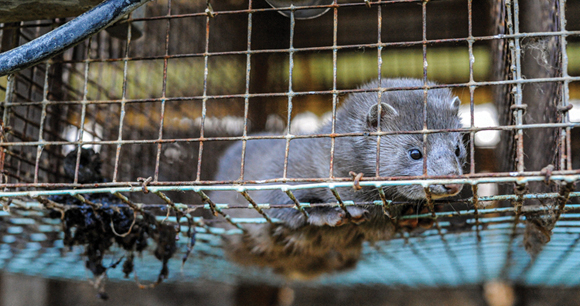
Highly Pathogenic Avian Influenza Creates New Threats to Oregonians, Wildlife
Salem, OR—Wildlife-advocacy and animal-protection groups sent an urgent letter today calling on Oregon Gov. Tina Kotek and state officials to address mink fur farms’ escalating threats to public health and wildlife.
The groups are asking the governor to fast-track phasing out commercial mink fur farming in Oregon to stanch the significant risk of dangerous zoonotic diseases being spread from these operations.
The groups’ letter also requests that disease surveillance and control measures quickly be put in place to help prevent the spread of viruses like COVID-19 and avian influenza, which threaten Oregonians and wildlife.
“The spread of these highly contagious, extremely deadly diseases among commercially farmed mink poses growing threats we can’t ignore anymore,” said Hannah Connor, environmental health deputy director at the Center for Biological Diversity. “Gov. Kotek has to act immediately to strengthen animal disease prevention and ultimately phase out commercial mink fur farming in Oregon.”
When bred and farmed for their fur, mink pose a particularly high risk to humans because their upper respiratory tract is similar to ours, making them potentially potent “mixing vessels” for generating novel pandemic viruses. Mink fur farms are also effective reservoirs for viruses due to their tightly confined and unsanitary conditions. COVID-19 affected multiple Oregon mink fur farms in 2020 and 2021, and several mink who tested positive for the virus escaped into the wild.
“Mink on fur farms incubate diseases such as COVID-19 and avian influenza, creating the perfect conditions for new variants to jump to humans—with potentially devastating results. Mink farms risk worsening the current pandemic and ushering in the next one,” said Kate Dylewsky, assistant director of government affairs at the Animal Welfare Institute. “This public health threat is dire, and we hope that Gov. Kotek will act quickly to end mink farming in Oregon.”
In recent months, highly pathogenic avian influenza, or HPAI, has spread in European fur farms, increasing concerns among scientists about the virus mutating and spreading among humans. Farmed mink in Europe are understood to have contracted HPAI from wild birds and then rapidly infected each other with the virus.
HPAI is also prevalent in wild and commercially raised birds in Oregon, increasing the chances that local mink farms could become the next outbreak sites. HPAI can be asymptomatic in farmed mink, which means that improved viral surveillance is vital to reduce risk.
“Fur factory farms pose a clear biosecurity risk to Oregonians and the state’s wildlife, yet are left essentially unregulated,” said Haley Stewart, senior program manager for wildlife policy at the Humane Society of the United States. “Short of closing the handful of fur farms that remain in Oregon, the state must implement regular inspections and require thorough monitoring for infectious diseases to help prevent future pandemics.”
Infected mink can also imperil Oregon wildlife. Studies show that HPAI can have a remarkable ability to infect mammals, including carnivores like mink. Oregon is home to several carnivores similar to mink, like river otters, and federally protected species such as Humboldt martens and wolverines. One endangered Pacific fisher, another carnivore similar to mink, has already been confirmed to have contracted HPAI in the wild.
“As disease transmission vectors, mink fur production facilities pose a risk to public health and human safety,” said Jennifer Hauge, senior legislative affairs manager at the Animal Legal Defense Fund. “Mink farms, in particular, house animals in cruel, stressful environments in close proximity to each other so viruses can spread rapidly, which is why it is critical that Gov. Kotek take action on this issue.”
The additional consequences of further HPAI outbreaks in Oregon are potentially severe. Last November more than 700,000 chickens had to be killed in Oregon counties where mink fur farms operate after the birds contracted the disease. HPAI can also be dangerous, and even fatal, to humans, sometimes causing high mortality rates.
Marjorie Fishman, Animal Welfare Institute
[email protected], (202) 446-2128
Hannah Connor, Center for Biological Diversity
[email protected], (202) 681-1676
Emily Snow Ehrhorn, Humane Society of the United States
[email protected], (202) 779-1814
Mike Heymsfield, Animal Legal Defense Fund
[email protected], (707) 364-8387
The Animal Welfare Institute (awionline.org) is a nonprofit charitable organization founded in 1951 and dedicated to reducing animal suffering caused by people. AWI engages policymakers, scientists, industry, and the public to achieve better treatment of animals everywhere—in the laboratory, on the farm, in commerce, at home, and in the wild. Follow us on Facebook, X (formerly Twitter), and Instagram for updates and other important animal protection news.
The Center for Biological Diversity is a national, nonprofit conservation organization with more than 1.7 million members and online activists dedicated to the protection of endangered species and wild places.
The Humane Society of the United States: We fight the big fights to end suffering for all animals. Together with millions of supporters, the Humane Society of the United States takes on puppy mills, factory farms, the fur trade, trophy hunting, animal cosmetics testing and other cruel industries. Through our rescue, response and sanctuary work, as well as other direct services, we help thousands of animals in need every year. We fight all forms of animal cruelty to achieve the vision behind our name: a humane society.